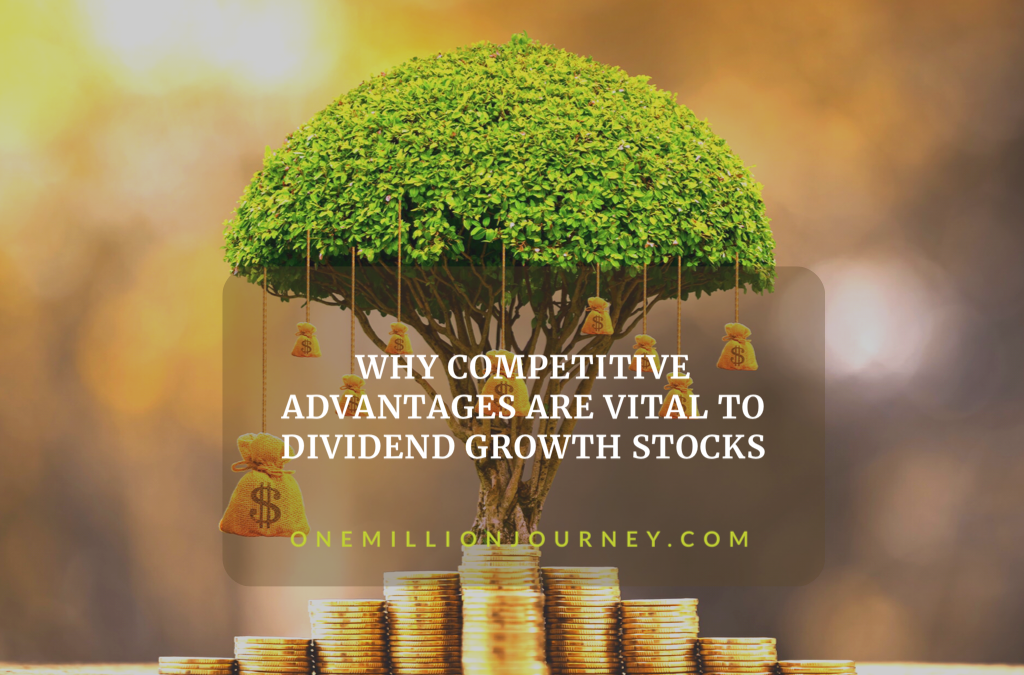Why Competitive Advantages Are Vital To Dividend Growth Stocks
This is a guest post written by Bob Ciura from Sure Dividend, on why competitive advantages are vital to dividend growth stocks. Read Bob’s biography at the bottom page.
At Sure Dividend, we are big proponents of investing in high-quality dividend growth stocks. While there are thousands of dividend stocks to choose from, we recommend investors focus on companies with the longest histories of dividend growth.
One example is the list of Dividend Aristocrats, a group of 64 stocks in the S&P 500 Index that have each raised their dividends for at least 25 consecutive years. We believe the Dividend Aristocrats have proven business models that can generate rising profits and dividends year after year.
Competitive advantages have a lot to do with this. In our view, durable competitive advantages are one of the biggest reasons for a company’s long-term success. Therefore, we believe investors should heavily consider competitive advantages when selecting dividend stocks.
Table of Contents
What Is A Competitive Advantage?
As the name suggests, a competitive advantage is the quality of a business that sets it apart from the competition. In any given industry, competition is fierce. When it comes to most products or services offered to consumers, new competitors are always trying to invade an existing leader’s territory. There are very few business areas in which a company’s products cannot be replicated (or at least emulated) by a new competitor.
Legendary investor Warren Buffett popularized the term “economic moat” to describe the benefit of competitive advantages. Investors can think of it similarly to a moat that protects a castle from invasion. The wider the moat, the better the chances of surviving an attack. Buffett himself utilizes this heavily in his own investment decision making—many of Berkshire Hathaway’s investment holdings include companies with wide economic moats.
Because of this, it is critical for a company to protect its business from the threat of competition. There are many ways a company can do this.
Most Common Competitive Advantages
Brand strength is one of the most common ways a company establishes itself from the competition, across a number of industries such as technology and consumer products. Having a strong brand can be crucial for a company. Imagine there are two competing products on a store shelf which are highly similar in terms of price and ingredients. Which product the consumer purchases could simply be a matter of brand power.
Companies have a number of tools to expand their brand strength, primarily through advertising and marketing. This is why so many large consumer products companies spend heavily on advertising every year. Consider that Dividend Aristocrat Coca-Cola (KO) spends over $4 billion per year on advertising, as it continues to wage a never-ending war with fellow Dividend Aristocrat PepsiCo (PEP) for dominance in the sparkling beverage industry.
Another way that a company can build its brand strength is through investment in research and development. This is particularly true in the technology industry, where developing new products is vital to staying ahead of the competition. In technology, trends change rapidly, which requires significant capital allocation to R&D.
Another form of competitive advantage is economies of scale. As a company becomes larger, it can capture economies of scale by increasing production at a higher rate than its costs. In this way, it can produce more while lowering its cost per unit. Reaping economies of scale allows a company to offer lower prices than its competitors, especially if those competitors do not enjoy the same scale benefits. For example, the rise of retail giant and Dividend Aristocrat Walmart (WMT) was due mainly to its ability to offer lower prices than its rivals. This ability to lower prices was based on its focus on minimizing costs and maximizing economies of scale.
Economies of scale can be found in many areas of the business model, including production, distribution, both internally and outside the organization. Companies that master economies of scale tend to generate higher profit margins than less-efficient competitors. In turn, the more profitable operators can expand faster and pay higher dividends to shareholders.
Dividend Aristocrats: Proven Competitive Advantages
The Dividend Aristocrats have collectively demonstrated that they have durable competitive advantages. The reason is simple—no company can maintain a long history of over 25 consecutive years of dividend growth, without possessing significant competitive advantages. Competition is so fierce across industry groups, that it would be nearly impossible for a company to make it onto the list of Dividend Aristocrats without its competitive advantages intact. Put simply, companies that do not possess competitive advantages do not maintain the track records of steady growth over so many years, to earn a place on the list.
This matters a great deal, as the Dividend Aristocrats have generated superior long-term returns, in bull markets or in bear markets. Dividend growth stocks are highly appealing for income investors—during economic downturns, dividends provide a buffer against falling share prices. In bull markets, dividends are basically a cherry on top of the total return sundae. Over the past 10 years, the Dividend Aristocrats outperformed the broader market. In the 10-year period ending January 31st 2020, the Dividend Aristocrats Index outperformed the S&P 500 Index by 0.4% annually.
While not all Dividend Aristocrats will outperform the broader market over the next 10 years, many of them will, and it will be due in large part to their various competitive advantages. Investors can buy all of the Dividend Aristocrats at once, through the ProShares S&P 500 Dividend Aristocrats ETF (NOBL). NOBL has over $5 billion in assets and an annual expense ratio of 0.35%.
As of January 29th, NOBL owned all 57 Dividend Aristocrats at that time. Standard & Poor’s recently added 7 stocks to the list of Dividend Aristocrats for 2020, bringing the total number to 64. NOBL will almost certainly add the additional 7 Dividend Aristocrats to its holdings soon. We believe NOBL is the best dividend ETF.
Final Thoughts
Whether investors buy the Dividend Aristocrats individually or invest in them through the ETF, we believe the Dividend Aristocrats are likely to deliver superior long-term returns. Their excellent track records of rewarding shareholders with higher profits and dividends is due, in large part, to their competitive advantages. We believe the Dividend Aristocrats widely have strong brands, efficient operations, and the ability to grow their profits from year to year. As a result, these stocks are highly likely to continue raising their dividends each year.
Related content: Onemillionjourney dividend growth stocks portfolio
Tags In
Bob Ciura
Related Posts
2 Comments
Leave a ReplyCancel reply
ABOUT ME
SUBSCRIBE TO BLOG VIA EMAIL
FINANCIAL TOOLS I USE
Online Banking
Crypto
Zero Commission Stock Investment Apps
(free share worth up to €/£100)
Index Funds Investing Accounts
(up to £50 bonus)
(no management fee for 1 year, Spain only)
Others
(Get it for FREE)






 Hi there! It's Tony here and I am hoping to post my journey towards one million euros.
Hi there! It's Tony here and I am hoping to post my journey towards one million euros.
Thanks for putting this post by Bob from Sure Dividend together. I am a big fan of companies with sustainable competitive advantages for the long term as well. I love Sure Dividend’s focus on the long term and on quality stocks.
My pleasure, thank you for reading Graham. I agree Sure Dividend’s investing philosophy is what makes the most sense to me, a buy and hold quality stocks forever.
I also enjoyed your guest post from your blog of “why income investors should consider the dividend kings 🙂